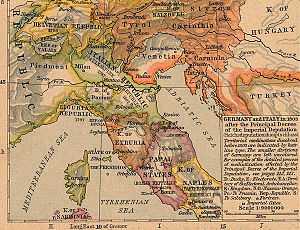Venetian Province

The Venetian Province (Italian: Provincia Veneta, German: Venedig Provinz) was the name of the territory of former Republic of Venice ceded by the French First Republic to the Habsburg Monarchy under the terms of the 1797 Treaty of Campo Formio that ended the War of the First Coalition. The province's capital was Venice.
In the course of the French Italian campaign of 1796, the Signoria of Venice under Doge Ludovico Manin had rejected an alliance with Napoleon, whereafter Bonaparte occupied the city on 14 May 1797, while the Republic had been disestablished and the government dissolved. In turn for renouncing all rights to the Southern Netherlands and the recognition of the French Cisalpine Republic, Emperor Francis II of Habsburg gained the conquered Venetian territory including the Dalmatian coast, except for the Ionian Islands.[1]
The province was incorporated as a separate part of the Austrian archduchy, where Francis took the additional title of a "Duke of Venice", it was however not subject to the Holy Roman Empire. The province was directed by an Austrian governor, but continued to use former Venetian legislation and maintained its currency, the Venetian lira. The western border of the province was shifted in favour of the Cisalpine Republic by the 1801 Treaty of Lunéville, and drawn up along the thalweg of the lower Adige river.[2]
The province had not a long life. After the Grande Armée had defeated the forces of the Austrian Empire at Austerlitz, Francis according to the 1805 Treaty of Pressburg had to cede the Venetian territory to the Napoleonic Kingdom of Italy. In 1815 it returned to Austria by the terms of the Final Act of the Vienna Congress and became part of the crown land of Lombardy-Venetia.